The time has come to review the third and final part of the Imbalance comic. How does it hold up? I would say about as well I expected. But let’s dive deeper into what actually happens.
Imbalance part three picks up pretty much exactly when the previous book left off. Toph has suggested that Aang take Liling’s bending. Needless to say, the proposal doesn’t sit well with the rest of the Gaang. Katara reacts with outrage, then when Toph says that Aang had already taken Ozai’s bending, she argues it’s not the same thing. Toph doesn’t see it this way and takes it personally because it’s her father’s factory that’s under threat. Also, it was she who had been buried under rubble. Katara, meanwhile, believes that bending is part of someone’s identity.
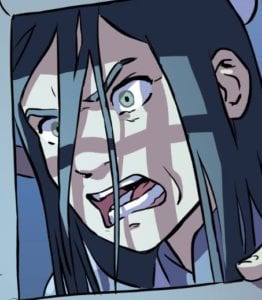 Aang is, as it so often happens, undecided. He goes to talk to Liling instead, but this (predictably enough) doesn’t go well. She’s smug… except for when Aang brings up his handling of Ozai. Liling then becomes angry and claims he should have killed him instead. Life without bending isn’t worth living, according to her. That’s all Aang can really get from her.
Aang is, as it so often happens, undecided. He goes to talk to Liling instead, but this (predictably enough) doesn’t go well. She’s smug… except for when Aang brings up his handling of Ozai. Liling then becomes angry and claims he should have killed him instead. Life without bending isn’t worth living, according to her. That’s all Aang can really get from her.
In the meantime, Liling’s daughters plan to break her free. Yaling’s bending comes back and she springs to action immediately… but Ru is visibly out of sorts. Yaling’s plan turns out to be to set fire to the Council building, where Lao and other non-benders have gathered. This distracts Aang and the others while she and some other benders storm the factory where Liling is held. The non-bender guards can’t hold them off for long and the benders succeed — Liling goes free.
The villains’ distraction having worked, the heroes arrive too late. Their spirits are rather understandably low, as Liling is once again one step ahead of them. The leader of the non-bender guards remarks on how it wasn’t their first time fighting benders, but they still lost badly. Then she asks if Suki could teach her and her people chi-blocking. Suki agrees, even though she doesn’t exactly have the time to cover more than the basics.

Liling returns home to her other daughter. Ru suggests escaping, as the Avatar will surely be after them now. Her mother disagrees, however. They had already run once — from Ba Sing Se. As it turned out, she and her daughters were there when Azula took over and had to flee with nothing but the clothes on their backs. Aside from being clearly bitter about it in general, Liling blames it on the Earth King being a non-bender. If he was a bender, she argues, he would have been able to control the Dai Li and protect his city.
Curiously enough, she doesn’t blame Ozai or the Fire Nation at all. Ozai was merely doing what any bending ruler would have done — exploiting a weakness. This proves the final straw for Ru, who asks if she is also a weakness, since she’s not a bender. Liling tells her that obviously she loves her as much as she does Yaling… but non-benders are powerless compared to benders and she has to accept that. This is about as reassuring as you would expect.
Next, we see Suki training the new chi-blocker corps, while Sokka and Aang watch. Sokka seems to have no interest in learning chi-blocking, as usual. He and Aang talk more about Liling and Aang is still unsure if taking her bending wouldn’t have been the better option. Sokka is skeptical, as that wouldn’t have ended the movement. Would Aang be willing to take the bending of every rebellious bender? At the risk of repeating myself, who could have thought that removing a leader won’t instantly decapitate their following?
Aang continues to agonize over the changing, progressing world. He blames the machines for causing the problems, just as they had enabled the Fire Nation’s war of conquest. Sokka disagrees, pointing to the benefits of industry, particularly for non-benders. They are what allows them to match benders’ capabilities. Ultimately, he argues, the blame for the current conflict is with benders running around destroying things. Just like the blame for the war lay with Fire Lord Sozin and his descendants.
This reassures Aang, who decides to head off to sleep. Sokka remains to wait until Suki finishes her lesson… which turns out to be an impactful decision, as he spots someone lurking nearby. He correctly assumes it’s Ru. The young woman is still torn between loyalty to her family and doing the right thing. Sokka encourages her by using Zuko as an example of how someone turned on their family to do good.
Ru reveals her mother’s plan to attack Earthen Fire Industries with a force of benders. She suggests that the Gaang leave, but they’re having none of it. They plan to fight, while Ru still asks them not to hurt her mother — only stop her. Her other request is… to study chi-blocking.
The scene cuts to Aang waiting atop Earthen Fire Industries. The entrance to the factory had been blocked off by a metal maze. Everything is silent and empty like a street in a western just before the big fight. A pair of people come with a cart. They’re benders who had brought supplies for their non-bender neighbors. However, while they don’t agree with Liling’s message, they’re not willing to stay and fight when she and her mob arrive.
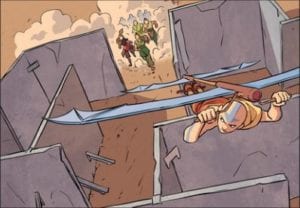
Liling’s demand is simple — all non-benders are to leave Cranefish Town and leave it to benders. Does she include her own daughter in it? Aang of course refuses and the battle begins. He flees with his glider and the mob displays rather poor tactical thinking by rushing into the maze. As they encounter a dead end, the walls begin moving on their own… or rather, it’s Toph moving them. She proceeds to move another wall, revealing Suki and the new chi-blocker corps. This fight is a lot more even than the last and the benders are forced back.
Fleeing through the maze, they run into more traps, this time involving Katara’s waterbending. Liling is not amused and she orders Yaling to deal with Toph. Yaling uses her earthbending to catapult herself over the maze… one wonders why the others hadn’t tried that. She also exploits Toph’s blind spot this way, as she can’t hear her coming if she doesn’t touch the ground. A fight ensues that eventually takes them to the rooftop.
Part of the mob breaks into the factory, where only Sokka and Satoru await. The former with his boomerang, the other with… a pipe. When the benders ask if they’re chi-blockers, Sokka bluffs that he is, which stops them long enough for one of them to take a boomerang to the head and pass out. Sadly, the others don’t run away as Sokka had hoped. But then Toph and Yaling conveniently break through the ceiling. The former nonchalantly traps the benders in a few sheets of metal and continues her duel.
Outside, Laling wonders how the Gaang knew they were coming and how to prepare. Ru then openly admits to having revealed the plan and denounces her mother. She demands that she call off the attack and attacks when Liling refuses.
Sadly, one evening of chi-blocking training isn’t quite enough and Ru ends up on the ground in short order. Liling is so incensed by the attempt to chi-block her that, in keeping with the Avatar world’s best parenting traditions, declares that she’ll bury her. As Aang notices that and heads in their direction, the scene cuts.
Toph and Yaling continue to duke it out, but Yaling eventually gains the upper hand. With Toph on the ground and at her mercy, she gloats about how stupid it is for a bender to be friends with non-benders. They are, after all, better than them. Toph says she’s not stupid enough to believe she’s better for having bending… and Sokka knocks Yaling out with his boomerang. Toph shows her gratitude with a shoulder-punch like she usually does.
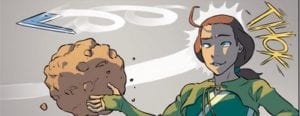
Outside, Aang and Katara spot Liling’s attempt to bury her daughter alive. Aang swoops into the rescue, knocking Liling back with a wind blast before it can happen (Katara, sadly, does very little). Liling isn’t down for the count yet and earthbends a massive boulder, claiming that Aang can’t stop her message.
Aang retorts that he can stop her and goes into the Avatar State. He traps Liling in an ice prison and seems to be ready to take her bending. Katara immediately tells him not to, while Ru encourages him. It’s the only way her mother will understand, she says. Katara, however, tells Aang to question his motives. Is he doing this for the right reasons, or just because it’s an easy solution and he’s angry? In the end, Aang backs down and simply vows to keep fighting Liling’s poison.
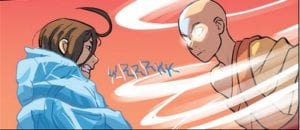
As the story wraps up and order is restored, the newly chi-blocking guards begin to form a non-bender police force. Of course, benders will need to join the police as well. Satoru doubts that benders and non-benders can truly work together, but Aang and Suki are confident they can. Ru watches her imprisoned family and blames herself for not doing something sooner, but Suki says that the important thing is she did do it.
Later on, Aang isn’t as certain about it all as he’d claimed. He has another heart-to-heart with Sokka about how new problems just keep cropping up and he can’t fix them. Sokka once again points out that he did help things and things will turn out alright.
The story ends with Aang explaining why he chose not to take Liling’s bending in the end. He says that while it was an obvious solution, her bending wasn’t the problem — her bigotry was. Thinking back to the pair of benders he’d met, he believes they hadn’t done enough to help. He decides to stay in Cranefish Town to keep steering things… while declaring that it’ll need a new name. We know that that name will be, don’t we?
Well, here we are. The Imbalance trilogy is over now. Did it meet my expectations? I would say it did, after turning things over in my head somewhat.
The core conflict of the story is handled decently. Of course, it could be better, but there’s only so much you can do in a fairly short comic book while also leaving room for action scenes and character moments. The inherent power gap between benders and non-benders is clear to everyone and the question becomes how to avoid it breeding conflict.
An important thing is that no one really treats the problem as having been solved or dealt with. The heroes have averted a major crisis that would have ignited the tensions and made things much worse. But the tensions aren’t going to disappear, even if Aang had taken Liling’s bending.
As hopeful as the heroes are for the future and continuing to fix things… we know they won’t. Because decades, a certain masked demagogue is going to stir up an entire revolutionary army.
This is rather evident in how Aang and Suki plan to create a chi-blocking police force. An eminently reasonable course of action, naturally. Only… we don’t see anything of the sort in Legend of Korra. The only chi-blockers are those working for Amon. After the Equalist movement falls apart, we never hear about it again. So what happened to those chi-blocking police?
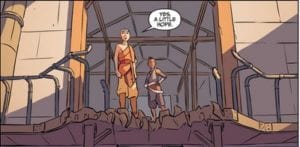
After giving it some thought, however, I realized that I can’t reasonably expect Imbalance to adapt to a poor story that was written years before. Faith Erin Hicks had a job to do — write a story about a conflict between benders and non-benders. She did it well and trying to tie it into the first season of Legend of Korra would have got in the way. Intentionally or not, Imbalance is essentially a do-over of the concept.
On a note more specific than the conflict in general, Liling is a solid, if not ground-breaking villain. She has a fairly consistent and believable philosophy, summed up as “might makes right”. Benders are stronger, thus they’re better. That’s the way of the world. Her escape from Ba Sing Se adds a personal motivation that fits in her larger beliefs.
She’s also a rather refreshing departure from the Avatar franchise’s treatment of mothers as saintly or absent. Liling is a villain and a mother both. And while she says she loves and cares about her family, this ends abruptly once one of her children actually dares to oppose her. Her attitude towards Ru is all too familiar from real life. She doesn’t hate her for being a non-bender, as long as she knows her place. Real-life bigots can be very flexible when it comes to tolerating the “good” members of the groups they despise, after all. Up to a point, that is.
Aang’s refusal to take her bending is something I expected, so it came as no surprise. I expect it to be divisive among readers. It gets a decent amount of consideration and discussion. Katara opposes it, claiming that bending is part of someone’s identity and that removing it isn’t actually non-violent. She also suggests it’s an easy and quick solution, but not necessarily a good one.
The rest of the characters act in ways he would expect. Aang wants to save everyone and bring peace, but struggles as to how. Katara… is his supportive girlfriend with little agency. Her main role is dissuading him from taking Liling’s bending away.
Sokka continues to play a fairly central role as the Gaang’s primary non-bender. Suki, normally very much a supporting character, also gets a somewhat major role by training the guards. It’s a little funny how chi-blocking is the non-benders’ go-to anti-bender strategy. Their “magic bullet”, as it were. No other weapons seem to be under consideration. Sokka continues to decline to learn it, but his insights into the situation influence Aang’s decisions considerably. Which I think is fairly satisfying as far as his impact goes.
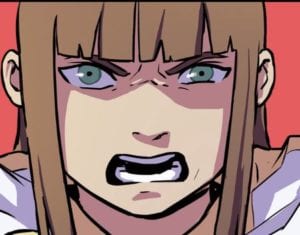 Ru proves to be instrumental to dismantling the bender supremacists’ plan. Having it all come down to a non-bender in a bender supremacist family is a good choice, I think. The parallel to Zuko is obvious and noted in the narrative, but in general, the more agency non-benders get, the better. Her fate seems to be open as if she doesn’t know what she’ll do next. Will we be seeing more of her?
Ru proves to be instrumental to dismantling the bender supremacists’ plan. Having it all come down to a non-bender in a bender supremacist family is a good choice, I think. The parallel to Zuko is obvious and noted in the narrative, but in general, the more agency non-benders get, the better. Her fate seems to be open as if she doesn’t know what she’ll do next. Will we be seeing more of her?
All in all, I think the Imbalance comics are a marked improvement over some of the previous ATLA comics. They also tackle the topic of bender/non-bender tensions far better than the franchise’s previous attempt. They’re not perfect, by any means, but I reminded myself of the danger of setting my expectations too high. The story remains fairly mature and engaging within its format.

